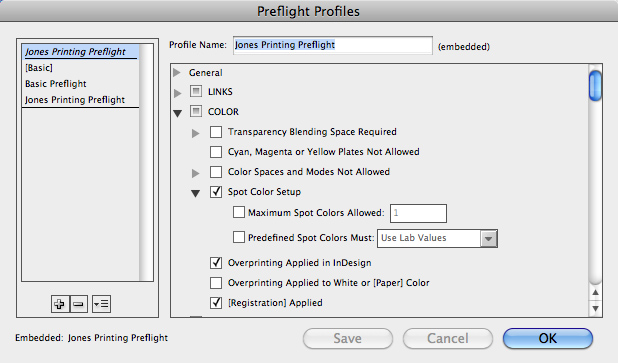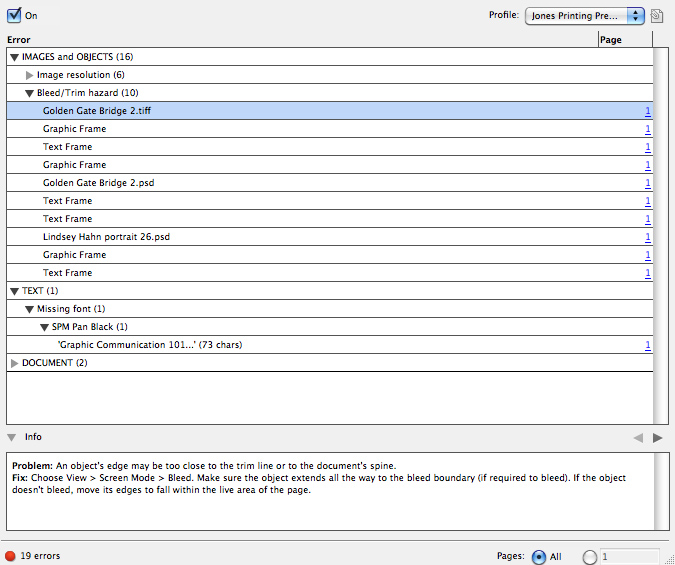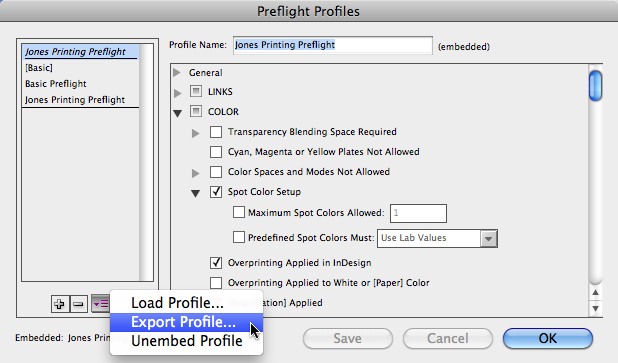The responsibility for preflighting a job prior to printing has been for a long time the aegis of the prepress professional. It is logical that preflight should be carried out in the prepress department as a job makes its way into production.
But, preflight is an expensive task in terms of job cost centers. Typical charges for prepress work are $2 to $5 per minute, and this work runs-up a significant charge against the job as it makes its way through production. For some preflight tasks, the work really should be done in the printing plant. I’m referring here to the need to monitor trapping, overprint, bleed, checking that the correct color profiles have been used.
But the lighter side of preflight can easily be done by the designer or page layout artist, and it should be done there. The tasks I am referring to here include checking spelling, checking for missing fonts, repairing missing links, and making sure that all the parts are in all the right places.
The prepress pros can contribute to the preflight process by making InDesign Preflight Profiles (one is shown above) that are customized for their production requirements, and providing these templates to their designer clients. These preflight profiles can (should) be posted on the printing company’s web site along with color profiles and PDF presets to aid the customer in preparing artwork for production that is perfectly ready for production.
InDesign’s Preflight tools are surprisingly effective at alerting design specialists to potential problems before they occur in production (and become very expensive corrections).
I made a profile this morning to demonstrate the process to my students. I set a few basic characteristics that are practical for sheet-fed production:
• Warn if bleeds are not present 0.125 in. all the way around the job
• Warn if artwork is too close to the edge of the sheet (less than 0.125 in.)
• Warn if the resolution of any color or grayscale image is less than 225 ppi or greater than 750 ppi
• Warn if the resolution of any bitmap (line art) file is less than 800 ppi or greater than 2500 ppi
• Warn if there are missing fonts
• Warn if there is any overset type
• Warn if a CMYK image will possible be processed a second time to a different CMYK
• Warn if any line is thinner than 0.1 pt. in thickness
• Warn if there is any type 4 pt. or smaller, and especially if it is made of more than one color
I saved my profile in the name of a fictitious printing company in Morro Bay, California (12 miles from here).
Then I ran the profile on a test sheet my students and I have been building. InDesign’s Preflight tool warned me that I had 19 errors. Some of these errors could be attributed to the fact that I was testing high-resolution line art scans to see where the best results could be found (2400 ppi), and a couple of the errors I wrote-off to photos that were too high in resolution (never can be too rich or have too much resolution!).
This preflight error tells me that the photo identified is too close to the edge of the sheet without bleeding.
Curiously, a few of the preflight errors were legitimate, and it made me realize that I had made a few errors in creating the test sheet. I adjusted the position of a couple of images, stretching the bleeds off the page where they had only kissed the edge in our original design, and I changed the file type of one of my images before replacing it in the layout (I had put a GIF file into the layout, which was certainly going to cause trouble later).
I am an advocate of PDF for all printing production, and I encourage all printing practitioners to provide the tools and instructional materials to their design clients to make press-ready PDFs as the only file that comes into the printing plant. I realize that some printers prefer to receive InDesign files, links and fonts (in a Package, I hope), but accepting the “native” files from customers is inviting trouble in my opinion.
So, providing a preflight profile, instructions on how to use it, and providing the best possible ICC color profiles (and instructions on their use) make it possible for the printing firm to pass the majority of responsibility for preflight upstream to the client, and thus reducing the cost and trouble of doing that work in the printing plant.
To export a Preflight Profile from InDesign, find this nearly perfectly hidden menu and save the file. Then, post the profile on your company’s web site and make an instruction sheet to tell your customers how to load it and use it.
And, printing companies can (should) provide a PDF preset for their design clients (with instructions) to assist in making a PDF that is truly press-ready.





The live preflight in Adobe InDesign is really powerfull, but you need the right profiles. You can download a great set of standard profiles from the VIGC website: http://www.vigc.org/standard-preflight-profiles/ They cover the same market segments as the PDF creation/preflighting profiles from the GWG, they prepare InDesign files for good PDFs according to the GWG requirements.
BTW: VIGC has also created a custom panel for Adobe InDesign, the VIGC Output Essentials, which will facilitate the preflight and also a lot of other stuff. You can read a nice review here: http://www.creativepro.com/article/vigc-output-essentials And you can download it here: http://www.vigc.org/vigc-output-essentials/
Both the preflight profiles, the panel are for free…
Eddy,
Thank you for your comment. I will explore these items, and write about my results.
Brian
The advice is very wise. Preflighting upstream is the true, lasting solution combined in many cases (not all) with PDF output. The only issue is I see no mention of FlightCheck or Ground Controls. What about QuarkXPress users? And those creating packaging or print designing in Adobe Illustrator? And let us now forget about Photoshop users, etc.
That is the power of Markzware FlightCheck, for yes, whom I represent for some 18 years. It can also preflight and package Adobe InDesign using pre-sets of preflight profiles we call Ground Controls, which can also be shared freely. It will also, in this same, easy-to-use, stand alone process, preflight and package Adobe Illustrator files, Photoshop and even individual print formats like tiff, eps and yes, even the resulting PDF job.
Here is a little video demonstration on FlightCheck. This, above everything mentioned, is the true way to push preflighting upstream and helps combat exactly what we show the production costs are in this print preflight triangle.
I hope this helps.
Friendly Regards,
David Dilling
Markzware